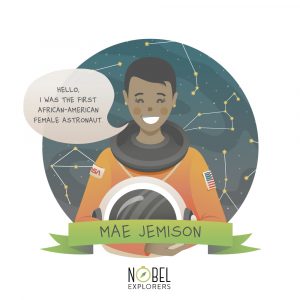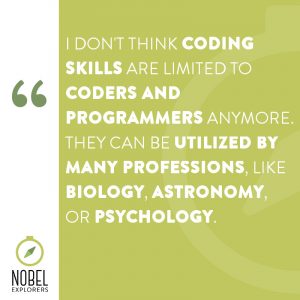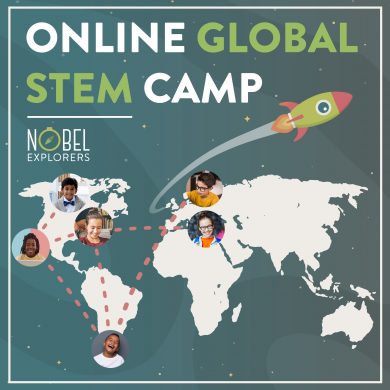Are Gifted Children Limited in a Traditional School Setting?
Sophie is an academic, test prep, and life coach at Nobel Coaching & Tutoring as well as project instructor and soft skills expert for Nobel Explorers. She is an authority on the topics of developing teamwork and leadership. Through 1-on-1 coaching sessions, she helps students improve both their academic and personal life, all the while learning about the challenges children are facing in the 21st century. Sophie shares her insights on gifted students, their characteristics, challenges they face, and what parents can do to help them reach their full potential.
Question: What does it mean to be a gifted student?
Sophie: The term itself is very much related to and represented in the field of educational psychology, and there are many definitions of what it means for a child to be considered “gifted”. The consensus is focused mostly around the fact that gifted children are those who have really high intellectual capabilities. Other definitions usually build on this in various ways, for example, adding into the mix other characteristics such as talents for specific activities. I myself prefer sticking to the first, narrower version of the definition because I believe it’s useful to make a distinction between “gifted” and “talented” children, since they will be different in terms of their advantages and challenges.
In an educational context, these children are advanced in their general intellectual activity, meaning they are likely to show success across most if not all subjects. They’re going to be good at both math and languages, science and humanities…
Q: So why don’t we just use the term “intelligent”?
S: All gifted children are highly intelligent, but not all intelligent children are gifted. When we talk about gifted kids, we assume they have innate high intelligence. However, you can have a very intelligent child who is not classified as gifted because they might have some issues in school. For example, they have ADHD or they struggle with executive functioning. So for a child to be considered gifted, they’ll need to have a combination of a very high IQ and good executive functioning skills.
Q: What would you say is the main game-changer for gifted children in the 21st century?
S: I feel like a lot has changed for gifted kids in the last 30 years or so. Mainly because before that, there weren’t that many specially designed programs for them to explore that would allow them to unlock their full potential. They used to be limited to the regular classroom with all the rest of the kids, which had its pros but some cons as well.
Q: How can we spot gifted students? What are some of the main characteristics of gifted students?
S: Gifted children seem to be gliding through school without any difficulty whatsoever, and this should be your number-one clue. If you’re a parent, you might notice that it takes them no time to finish their homework. You kind of get the impression that school is super-easy for them and they get through it without ever struggling.
These kids are able to adapt to new challenges pretty quickly and they easily grasp new ideas. For instance, when introduced to fresh materials in subjects like math, which most kids struggle with, they don’t require a lot of practice. Not only do they have the ability to acquire new concepts faster than the rest of their peers but they also learn to apply them really well.
Q: What would you say are some of the main obstacles gifted students face these days?
S: I think there are several issues for gifted kids in the traditional educational system. The main one is that they’re not really being challenged. Gifted children are probably bored at school. They’re probably bored out of their mind! If everything comes easily and naturally to them they’ll never have the opportunity to struggle and build resilience.
Finding something that actually challenges them will help them keep growing and learning to overcome obstacles. The obvious solution might be signing the child up for a gifted program or have them attend a school for gifted kids, but that comes with another set of issues. Sure, now they’re being challenged so that’s one less thing to worry about. Still, these kinds of environments tend to be really competitive and that can cause a lot of anxiety in a student. Even though they’re very good, even though they’re very smart, having to perform in a context that promotes competition can create a lot of pressure and have a very negative effect on a child’s mental well-being.
Another obstacle they face in today’s schooling system is that they never learn to properly work in teams. This is a big issue as regards modern and future workplaces. The set of challenges that humanity is facing nowadays is really complex. Let’s put it this way – if a problem was simple enough, we’ve already solved it. What we have today are challenges that require tackling from multiple angles, by experts in different fields. Having a good, strong team and knowing how to function in it is an essential skill for professionals in the 21st century.
Now, if you’re a gifted kid and you get teamed up with someone at your school in order to, say, complete a project, a couple of things can happen. Option one is you’ll be doing most of the work. This is teaching gifted students that teamwork is all about you doing the lion’s share of the work and other people just coasting along. But let’s consider that your teammates actually want to help. The gifted child still has very high expectations, which could make them want to contribute to other aspects of the project and take over assignments of others as well.
In the first common scenario, gifted students are learning others are lazy and don’t want to do their part. The second teaches them other people can’t really perform to their standard and since they’re fearing a lower grade, they think they have to do the work themselves.
The main factor at play is that they are not teamed up with people who are at their level of understanding. To really learn the value of teamwork you need to be on a team with people who have abilities or skills that are different from your own but at pretty much the same level. A context where either someone’s a little bit better or you’re a little bit better than someone else. As a group, you all need to function on a similar level in order to appreciate the value of working in a team as opposed to working by yourself.
Q: What can gifted children do in order to overcome these common challenges?
S: The main thing is to find an interest or a project that really challenges you and puts your capabilities to the test. That is something these kids lack in the school system. Go into something that doesn’t come naturally and doesn’t come easily. That might be learning a musical instrument or practicing a sport or it can be a host of different things, but find something that really feels challenging and you have to work for.
What’s difficult for you might not be for someone else, and will differ from person to person. Maybe you’re really talented at school but you struggle with sports, so getting on a sports team will put you in a situation where you can work at it and gain resilience. Or maybe you’re great at school but you want to get more familiar with a particular subject. Let’s say you’re looking into something like coding or web-design. You can pursue it and go deeper to a point where it becomes really challenging. Even if your school doesn’t provide you with a challenge, I’m sure there’s more to that area than what you’re able to learn in school.
The second thing is you need to find an environment where you can learn to collaborate with other people and that probably means finding a team that is at your level. So it can be extracurriculars, online classes, school newspapers, sports teams… Something that doesn’t come naturally, something that you really need to work for and that’s going to be very different for different kids.
Q: In your opinion, what is the number-one skill gifted children should focus on developing?
S: I think resilience is one of the most important skills that you can build, for all children. I think a lot of people view it as a trait and not a skill, but resilience is just knowing how to deal with obstacles. Not crumbling in the face of a challenge, but rather facing it head on and solving issues along the way. However, it’s a skill that a lot of people don’t learn and gifted kids are especially in danger of this since they meet fewer challenges early on. Everything comes easily to them which means they don’t have to learn resilience.
But in life, as they go through the educational system and into the workplace, they will definitely face challenges. They might, say, get into a very competitive college. Now, all of a sudden, they’re surrounded with a bunch of people who are as smart and as talented as they are and the workload is a lot greater. There’s a lot more stress than they’re used to, and if they’ve never learned how to face challenges properly, this is where they might crumble.
Q: What are some of the pros and cons of being a gifted student in the digital age?
S: Some challenges are universal to all kids and they apply for gifted students as well. For instance, the era of social media is shortening our attention spans, which is a challenge for adults as well. However, the opportunities of the digital age are really great. Online, you can learn anything. There are so many things to choose from and if you have the right mindset, you can find something that will challenge you and you’ll want to spend your time on. Unfortunately, what I’ve often seen is that people start learning something and then give up fairly easily. They take up a course, it seems really interesting and a couple of weeks in their motivation drops and at that point, they just stop investing in it. So the opportunities are there, but making the most of them is not that common.
Q: How can Nobel Explorers help gifted students reach their full potential?
S: Nobel Explorers is a great opportunity for gifted students. What we offer them is an environment where they can learn to collaborate with other people and where they can work on something challenging. The projects that they’re working on can’t be done by just one person. This means they’ll be working on an online, international team where everyone has their own role. This is something that mimics most of the workplaces you’ll find in the 21st century.
On one hand, they’ll have a team and their own role within that team so they’ll need to learn how to collaborate with the rest of the Explorers in order to complete the project. On the other hand, they’ll have the opportunity to go in depth on their area of expertise and interest. So let’s say their team is building a website and they’re the designer. Maybe they want to learn a little bit more about website design or graphic design in general. If they have extra time, they can go and do that without having to step on anyone else’s toes and overtaking other people’s assignments.
Gifted children need the right environment in order to reach their full potential.
At Nobel Explorers, they will work in a modern online STEM camp as part of a global team, alongside peers who share their interests and abilities, while learning essential technical, leadership, and teamwork skills.
BECOME A NOBEL EXPLORER!
Registration is OPEN!
Q: Can you share some tips for the parents of gifted children? What can they do to contribute to their child’s development?
S: Parents should let their kids face challenges and help them through them. I think a lot of parents fall into the trap of doing everything for them just so their child will be happy. It’s very normal to feel this way, but the parents tend to go into obstacle-removing mode. They remove anything from their child’s life that’s difficult or unpleasant. This is a problem because kids who are really sheltered won’t learn critical life skills they’re going to need as adults. You need to let them face and overcome their challenges, whatever they might be.
Whether they’re at school or they have social challenges with their friends, don’t remove the obstacle but teach them how to deal with it. You can start doing this when they’re very young. If your 5-year-old has a problem in the playground with another kid and they’re really sad or upset about something that this other kid did, you can be there and support them through that. But don’t simply take your kid out of that environment forever. These situations will be incredibly helpful for your child’s development.
There’s one more issue parents can help out with. Gifted kids can sometimes have very high expectations of themselves. Parents play an important part here, their influence being greater or smaller depending on the situation. Let’s consider a scenario where the child has high standards for their performance and their parents share these expectations as well. That can be a problem if the child is intellectually well ahead, but emotionally still on the same level as their peers. A typical 15-year-old, even though they’re really smart and have no problem grasping all the subjects intellectually, can still struggle with the pressure of it.
If you have a kid like that who is gifted but struggles with the pressure of performing at that level, help them lower the bar. It sounds counterintuitive but I’ve seen it first hand. These are usually kids who do math problems in their free time for fun. They don’t need encouragement. They need you to help them set the bar lower so that they can perform without feeling pressured. Help them understand and accept that they don’t “need” to get an A and you can suggest a less stressful goal, like getting a C, for example. What should happen is, even if they get the occasional B, they’re still probably going to get mostly A’s because they are still gifted, engaged, and interested. But by lowering the bar, you’ll be removing the pressure from the equation and reducing stress. Without pressure, there’s less anxiety, which means your child will be happier and healthier.
Our Coaches are experts in stress management and anxiety coping techniques that will improve your child’s performance and help them build resilience.
SCHEDULE A FREE CONSULTATION TODAY!

 Images children have about themselves are highly significant when it comes to their achievement in school. A confident child is ready to learn, cooperate with others, and behave as a responsible individual, especially with the guidance of a teacher and counselor [5] .
Images children have about themselves are highly significant when it comes to their achievement in school. A confident child is ready to learn, cooperate with others, and behave as a responsible individual, especially with the guidance of a teacher and counselor [5] . First, you can talk about those women who, throughout history, have excelled in science and math fields. History books and school curricula don’t place much emphasis on the influence women had in the past, so learning about women who were important for science is a great start. From Hypatia (Hellenistic philosopher, mathematician, and astronomer), to Ada Lovelace (considered the first computer programmer) and Marie Curie (conducted pioneering research on radioactivity), history is actually full of women who were essential to the advancement of science.
First, you can talk about those women who, throughout history, have excelled in science and math fields. History books and school curricula don’t place much emphasis on the influence women had in the past, so learning about women who were important for science is a great start. From Hypatia (Hellenistic philosopher, mathematician, and astronomer), to Ada Lovelace (considered the first computer programmer) and Marie Curie (conducted pioneering research on radioactivity), history is actually full of women who were essential to the advancement of science. Most studies about girls and STEM show there is a huge benefit in gathering a diverse group of girls together, paying attention to each one of them, and keeping the activities fun. Educators must strike a balance between holding girls to high expectations and providing freedom, socialization, and engaging STEM activities. Girls in focus groups said that an important part of this is the teacher’s understanding of adolescents and their culture [2]. There is significantly more to learning than just transferring knowledge, and individual attention and communication with and among students is really important to a good learning process [4].
Most studies about girls and STEM show there is a huge benefit in gathering a diverse group of girls together, paying attention to each one of them, and keeping the activities fun. Educators must strike a balance between holding girls to high expectations and providing freedom, socialization, and engaging STEM activities. Girls in focus groups said that an important part of this is the teacher’s understanding of adolescents and their culture [2]. There is significantly more to learning than just transferring knowledge, and individual attention and communication with and among students is really important to a good learning process [4].







